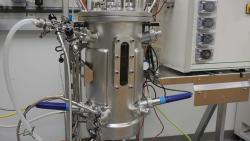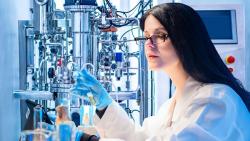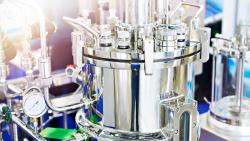
OR WAIT null SECS
- About Us
- Advertise
- Editorial Information
- Contact Us
- Do Not Sell My Personal Information
- Privacy Policy
- Terms and Conditions
© 2024 MJH Life Sciences™ and BioPharm International. All rights reserved.
Fermentation & Cell Culture: University Style
Use of a fermentor for cell culture study advances research in directions previously thought unimaginable.
It's definitely the exception to the rule for university-based research facilities to conduct cell-culture studies utilizing the capabilities of a fermentor. Recently BioPharm International capitalized on an opportunity to chat with noted cell culture researcher Scott Stevens, who currently is growing a diverse group of cultures with the use of a fermentor at his facility at the University of Texas at Austin, with noteworthy results.
Fermentation Facility at University of Texas at Austin
BioPharm: Describe the work you're doing in the laboratory at University of Texas at Austin and what you hope to accomplish.
Stevens: In my laboratory we study ribonucleoprotein structure and function, specifically the structure and function of those ribonucleoproteins involved in gene expression. The small nuclear ribonucleoproteins (snRNPs), which are our primary interest, are present in relatively low abundance (200 to 500 molecules per cell in yeast) making their isolation and structural characterization a particular challenge. We hope to determine the low-resolution structural arrangement of these snRNPs by cryoelectron microscopy and eventually, the high-resolution structure by X-ray crystallography. To produce milligram-scale quantities of these complex molecules that contain dozens of proteins and several small RNA molecules, we require multiple kilograms of yeast. The strains we use for these experiments contain specific modifications in several genes to facilitate the snRNP purifications, so we are unable to use commercially available wild-type yeast cakes.
BioPharm: What cultures do you grow in the laboratory?
Stevens: We primarily grow Saccharomyces cerevisiae in our laboratory, but we also grow Schizosaccharomyces pombe and Escherichia coli.
BioPharm: For what purpose(s) do you grow the cultures?
Stevens: For our large-scale microorganism growth, we generally use the product for protein or macromolecular complex purification. For S. cerevisiae and E. coli we perform preparative purifications of single polypeptides (E. coli), or multi-protein complexes (S. cerevisiae). For S. pombe we perform exploratory analyses of macromolecular complex composition.
BioPharm: Describe the processes and technology you originally employed to grow cultures and the progression to those you use today?
Stevens: Like most academic investigators performing similar experiments, we began experimentation using small-scale cultures of one to six liters in shake-flasks. We continue to perform small-scale experiments to troubleshoot and optimize our purification procedures. We now are able to routinely produce 400 liters of culture in a fermentor (500L Modular BioFlo Pro,New Brunswick Scientific [NBS]) in an overnight experiment. We find that although using the fermentor typically allows for faster and more dense culture growth, the procedures scale directly and the resulting product is identical to what is produced from smaller-scale cultures. We are currently attempting to optimize culture conditions with oxygen supplementation to increase the biomass yield at the end of the culture growth. With the equipment we use, there have been no challenges to overcome in scaling to this level, other than learning how to operate the equipment.
BioPharm: How customary is it for a college or university laboratory to use a fermentor to grow culture?
Stevens: In researching the purchase of the equipment for our facility, we found that many academic laboratories, departments, and colleges that used large-scale fermentation at one time have discontinued their use in the last several years. In the past decade or more, laboratories interested in milligram quantities of protein have dispensed with large-scale growth of microorganisms as bacterial over-expression systems have progressed to the point where hundreds of milligrams of product can often be purified from one to five liters of culture. In the current age of structural genomics where the low-hanging fruit of easily expressed single polypeptides will have their structures determined rapidly, these small-scale culture are ideal.
For investigators like myself who study polypeptides of up to 280 kD contained in macromolecular complexes composed of dozens of polypeptides and several RNAs, those structures will only be determined through the brute-force techniques we use to purify them from their natural hosts. Several factors prevent the conventional overexpression of snRNP polypeptides in bacteria. First, many individual snRNP proteins are insoluble in the absence of their binding partners. Second, many snRNP proteins are 100 to 280 kD in mass, making their overexpression in E. coli particularly difficult, if not impossible. Lastly, their structural context is lost when looking at single polypeptides. Only when looking at the whole assembly purified from their native organism can we be sure that we are studying the functional proteins and their arrangement in the intact snRNP. Their low abundance in yeast requires that we grow massive culture volumes to purify sufficient quantities of these complex molecules. I feel that after the low-hanging fruit has been picked, the future of structural biology will be found in large, often hard-to-isolate complex protein assemblies that will necessitate the use of large-scale fermentors.
Saccharomyces cerevisiae
BioPharm: Why did you invest in a fermentor?
Stevens: When I began my first independent position three years ago, I knew that my work would require the use of this type of fermentor. I was very fortunate to receive the funds from the University of Texas at Austin to build our fermentation facility. The benefits of this type of facility are the speed with which we can grow the yeast (approximately 400 liters per day) and the quantity of material we can obtain (tens of kilograms per week when running at full capacity). The setup we have installed in our facility makes it easy for one operator to perform the culture preparation, culture growth, harvesting of the culture, and processing of the resulting biomass.
BioPharm: How much time did it take from ordering the fermentor to its delivery?
Stevens: Our BioFlo Pro instrument was the first one of this size and design, so the design and build-out of the machine was performed in conjunction with NBS over the course of about six months. I'm not aware of how long it would currently take to produce this machine. (Editor's note: NBS states it now takes 12 weeks from order to delivery.)
BioPharm: Did you receive training to operate the fermentor? Is help readily available if you experience difficulties?
Stevens: We received two days of training on this machine, which was more than adequate. We were able to proceed through an entire fermentation run, from media preparation through harvesting of the product.
BioPharm: Who takes care of the maintenance of the fermentor?
Stevens: We maintain the entire fermentation facility with the staff in my laboratory unless we encounter difficulties or have questions that require the manufacturer, who is extremely helpful.
BioPharm: How large is the staff that it can maintain the entire facility?
Stevens: The equipment has been designed so that one individual can operate it. That said, the individual must be able to lift rather heavy supplies and equipment, making some of the steps (e.g., removing the full centrifuge rotor) much easier with two people.
BioPharm: How did you convince the university to fund a fermentation facility?
Stevens: I included the facility costs in my negotiations for my startup funds before coming to the university.
BioPharm: What was the cost of the fermentation facility?
Stevens: Although the cost of all the major equipment was approximately $250,000, a facility build-out will depend on the extent to which the facility is made user-friendly and the needs of the individual investigator.
BioPharm: How long did it take to build the facility?
Stevens: The build-out of the facility took about six months from the time the plans were finalized. A total of about one year was required for all of the planning, building, and equipment testing.
BioPharm: Can you modify the fermentor if your work requires it? Do you envision ever scaling up the volume you're producing? What would scale-up entail with the fermentor?
Stevens: One of the first considerations I addressed with NBS was the modularity of the machine. The design is such that we were able to add options during manufacture and after installation. Based on the scalability of our processes from shake-flask to 400 liters, I am confident that further scalability to larger volumes could occur should our experiments call for it.
BioPharm: How have your processes and results changed since using a fermentor?
Stevens: Using the fermentor has allowed my research to advance in directions previously thought unimaginable prior to obtaining the fermentor. Although it is possible to grow hundreds of liters of cells without a fermentor (albeit an extremely tedious and time consuming proposition), we find that the reproducibility and dynamic monitoring of variables such as dissolved oxygen, pH, temperature, and agitation speed allow us to predictably and reproducibly generate useful biomass for our experiments.
BioPharm: Is the fermentor integrated with any other technology in the laboratory/facility?
Stevens: Our facility has been designed for maximum flexibility and ease of use. In addition to the fermentor, there is a process steam generator (Electro Steam Generator). We use a CEPA Z-60 continuous-flow centrifuge for biomass harvesting. This centrifuge allows us to harvest 400 liters of culture volume in under an hour. We also have installed a 12-liter, small-scale fermentor (NBS) that can be connected through an in situ sterilizable connector (custom part, NBS) to feed the large fermentor.
To process the material obtained from the fermentor, we have the option of high-pressure pneumatic homogenization using a Microfluidics 110-EH unit, which homogenizes about one liter of re-suspended cells (about 300 grams) in under three minutes. We are also installing a bead mill (Glen Mills) for continuous cell disruption under chilled, low-pressure conditions. The facility also houses a whole-room chilled water system which allows us to tap into an in-room heat exchanger (System III, Thermo Electron) at any point along the walls to cool any of the devices we have installed to ~5°C.
BioPharm: If a colleague is considering using your strategy (a fermentor), what are your recommendations?
Stevens: I would strongly recommend that investigators interested in this type of facility installation meet with representatives from the manufacturers and consult architects to determine their needs and the best way to address them. For example, an important consideration for NIH protocol compliance was the containment of a bioproduct breach, either from a fermentor or centrifuge spill, or from a processing catastrophe. This necessitated the design of a containment system incorporated into the room, essentially making the whole room a waterproof containment pool. Containment breaches and routine facility cleaning and maintenance are performed by chemically sterilizing the entire facility before passing inactivated material down an otherwise sealed floor drain.
BioPharm: Does your laboratory have any business partnerships within the fields of biopharmaceuticals, traditional pharmaceuticals, or government?
Stevens: We are not currently in any business partnerships, nor are any planned in the near future. We do offer fermentation services and product homogenization to our local colleagues for a very reasonable rate. As our laboratory expands and our personnel increase, we hope to make these services available to laboratories outside our university.
BioPharm: As you believe the future of structural biology lies in the hard-to-isolate complex protein assemblies, do you feel that you're at the beginning of a trend in returning to the use of large-scale fermentors?
Stevens: It may very well be some years down the road, and certainly each large macromolecular complex will present its own technical challenges, but I think that there will be a number of structural biologists and collaborators who will choose to go this route. Roger Kornberg at Stanford University reported that crystallization of the RNA polymerase II complex from yeast required 10,000 liters of fermentation to produce the required amount of protein complex. Clearly the payoff was huge. I can see that this will be required in many other cases and that large-scale cultures will be the only way to address interesting biological problems. Investigators who employ brute-force approaches will be the ones who solve large, interesting structures.
Scott Stevens, Ph.D., assistant professor of molecular genetics and microbiology, University of Texas at Austin, 1 University Station, #A4800, 2500 Speedway, Austin, TX 78712-1095, 512.232.4303, Fax: 512.232,3432, scott.stevens@mail.utexas.edu



